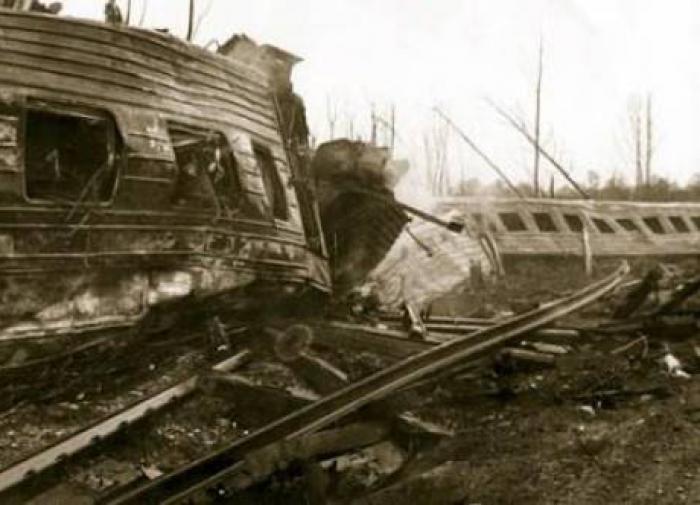USSR's biggest hell in peacetime: 1989 Ufa natural gas explosion
Two overcrowded trains, a mammoth explosion of natural gas that took place on a damaged pipeline and more than 600 fatalities. This is the aftermath of the largest railway disaster on the Trans-Siberian Railway that occurred in the area of the city of Ufa on June 3-4 overnight in 1989.

A rupture in the pipeline Western Siberia-Ural-Volga region, which passed along the railway, formed on the stretch between railway stations of Uglu-Telyak (Bashkiria) and Asha (Chelyabinsk region). The leak was not detected and fixed in a timely manner, which caused liquefied gas liquids to accumulate in the lowlands adjacent to the railway embankment for months, thus creating a flammable cloud.
On the night of June 4, two passenger trains were traveling towards each other in this place: Novosibirsk-Adler and Adler-Novosibirsk (Adler is a resort town on the Black Sea - ed.). There were about 1300 people in both trains. The first train was taking its passengers for holidays in Southern Russia, while the other one was taking holiday-makers home.
The explosion occurred at the moment when the oncoming trains were traveling in opposite directions at one and the same section of the railway lines. It is believed that it was wheel sparks from the two passenger trains that ignited the flammable cloud.
The explosion was monstrous: experts estimated its power at 300 tons in TNT equivalent. The pillar of the flame was seen a hundred kilometers away, and a massive fire embraced the area of 250 hectares.
All 37 cars and electric locomotives of the two trains were destroyed in the disaster. Seven cars burned down completely, 26 were scorched out from the inside, 11 others got detached and thrown off the tracks. The blast wave knocked down trees within a radius of three kilometers. As many as 780 people were killed.
Tamara Striga was a nurse anesthetist of the ER team. She worked on the site of the disaster in 1989 helping the survivors.
"Back in the day, I worked as part of the resuscitation team at the central substation. We left to respond to an emergency call at about four o'clock in the morning. We did not know the exact address - we could only see the glow, so we were going in that direction, and we didn't even know what happened there. We were only told that there was some sort of a catastrophe there, some sort of explosion - that was all we knew.
"We are in an oil-rich republic, and I thought what could have broken the pipe, the gas could have exploded. But no one could even imagine that at the time of the explosion two trains would be passing there. No one even imagined how many victims we would have to deal with and what kind of injuries they would be. We thought we were just going to a gas pipeline accident - it was not a first for us, we thought.
"We arrived there as two ER brigades - a resuscitation and a cardiological one. We arrived at the forest belt. It was very dark and there was no way to go further. Very soon, a fire engine drove out to us - they evacuated several people at once.
The first thing we saw on the site was three children, three teenagers. They were walking towards us like bats, their arms outstretched with flaps of skin hanging down from them.
The sight, of course, was terrifying: crushed carriages, charred bodies. When I was passing them by, I had a feeling that they were plastic dolls. There was a woman lying there on the ground. She was all glossy brown, had curly hair - she looked like a mannequin.
She had a skull injury and I could see her baked brain. What was the temperature there that the bodies got so charred?!
"There were a lot of bodies on the steps - apparently, of those who did not manage to jump out. Rescuers had to spend a lot of time looking for survivors in the woods as those who got lucky fled to safety in all directions, trying to run away from the fire.
"Afterwards, we talked to a military officer, his last name was Dontsov. He was conscious all the way to the hospital. He had 85 percent of body burns - he was doomed. He was in one of those trains with his soldiers who were going to the military school. When the explosion occurred he fell off the top bunk and, as he said, had only his watch left on him. The power of the blaze burnt everything instantly - that's how high the temperature was.
"The first thing that occurred to him was to try and help others. He started pushing soldiers out of the window as the explosion damaged all the doors. He did not think about himself.
"He only asked to let his wife know that he wanted her to marry another man some time - he did not want his little child live without a father. He knew he was not going to make it."
The details of the disaster became known a few months later. As many as 258 people died on the spot, more than 800 received burns and injuries of varying severity, 317 died at hospitals. The total number of victims was 575. However, there were many small children on the trains who were not listed as passengers. Today, the memorial board installed on the site of the tragedy counter 675 names. According to unofficial data, 780 people were killed in the deadliest rail disaster in peacetime in the Soviet Union/Russia.
After the tragedy near Ufa, other, less flammable and more heat- and fire-resistant materials were used for the assembly of passenger cars.
Subscribe to Pravda.Ru Telegram channel, Facebook, RSS!


